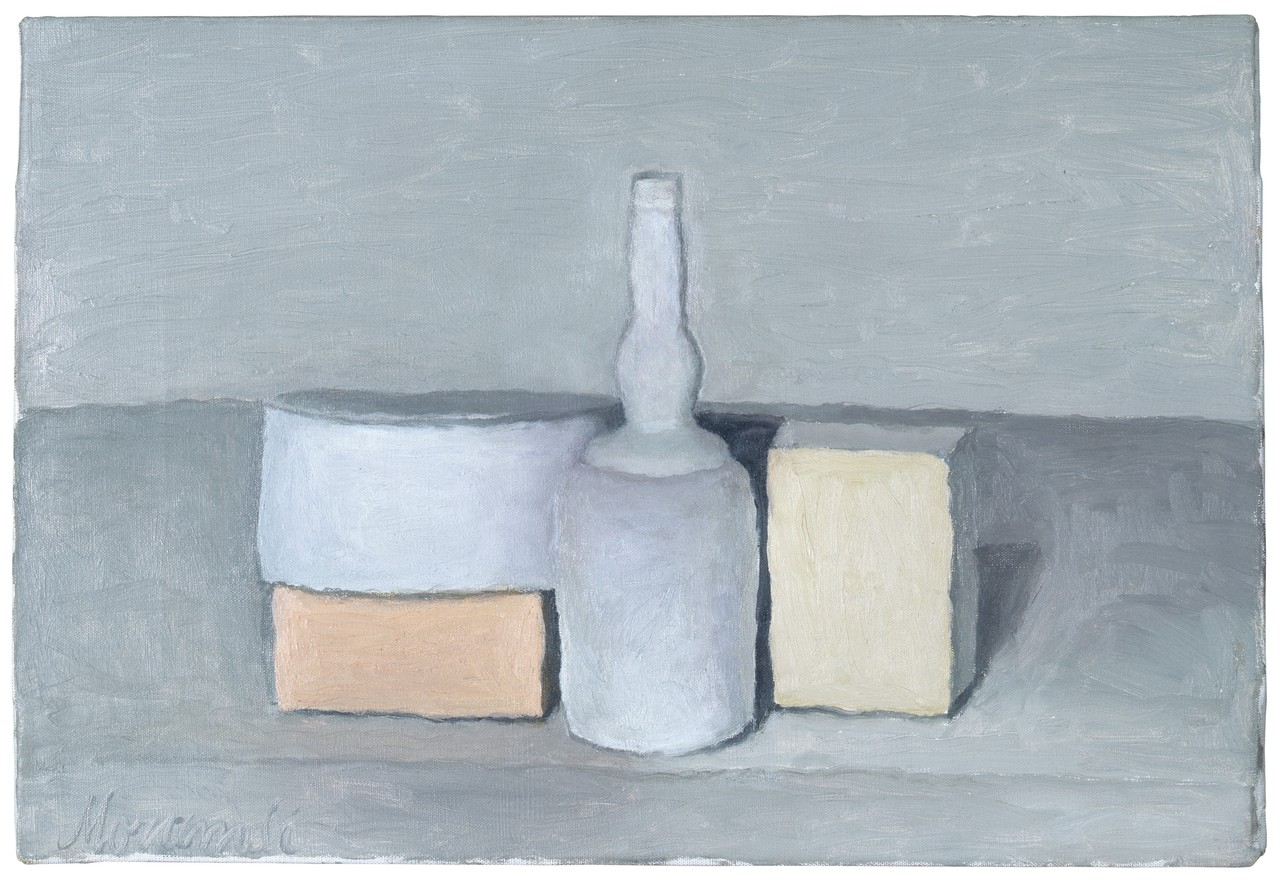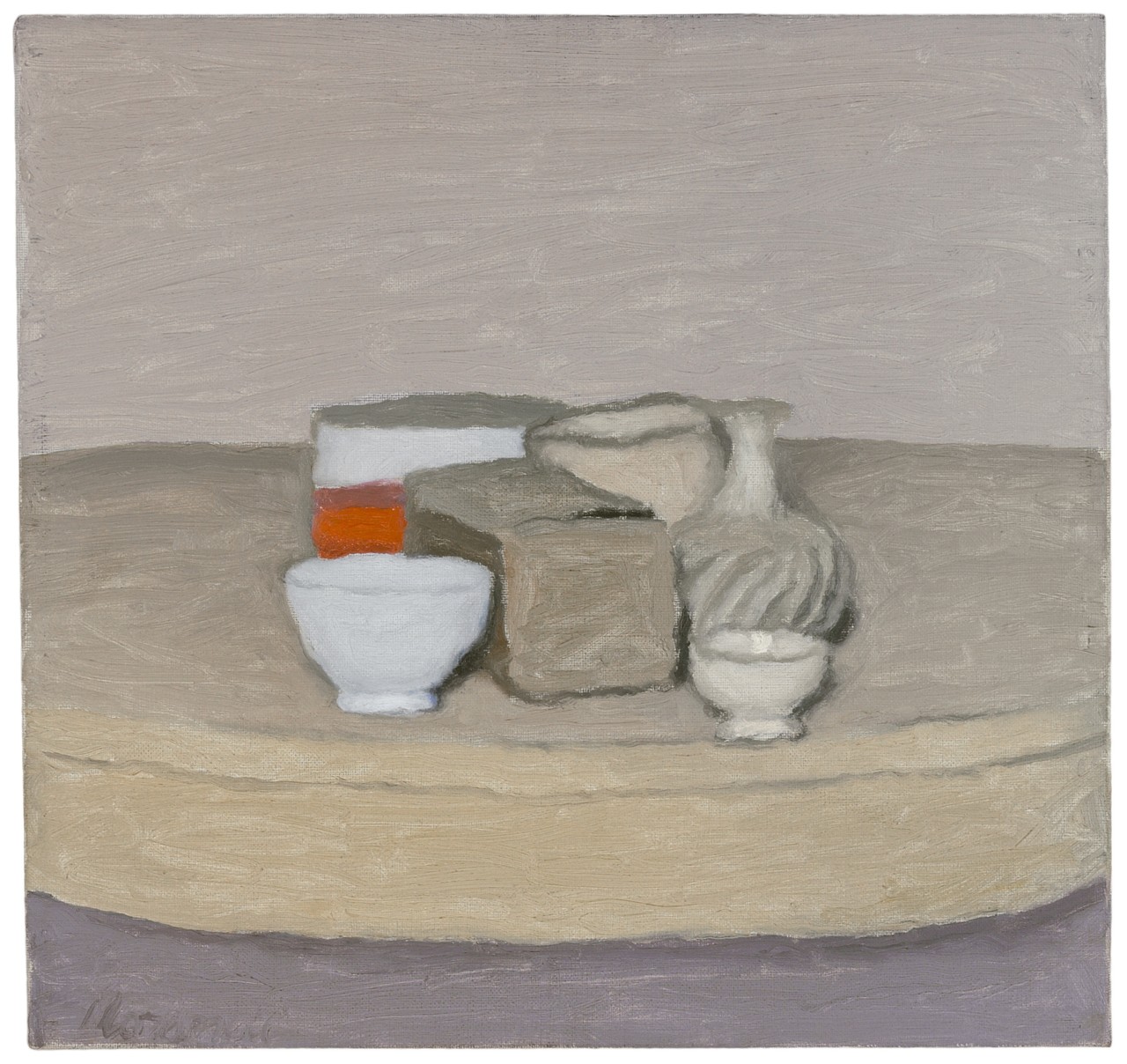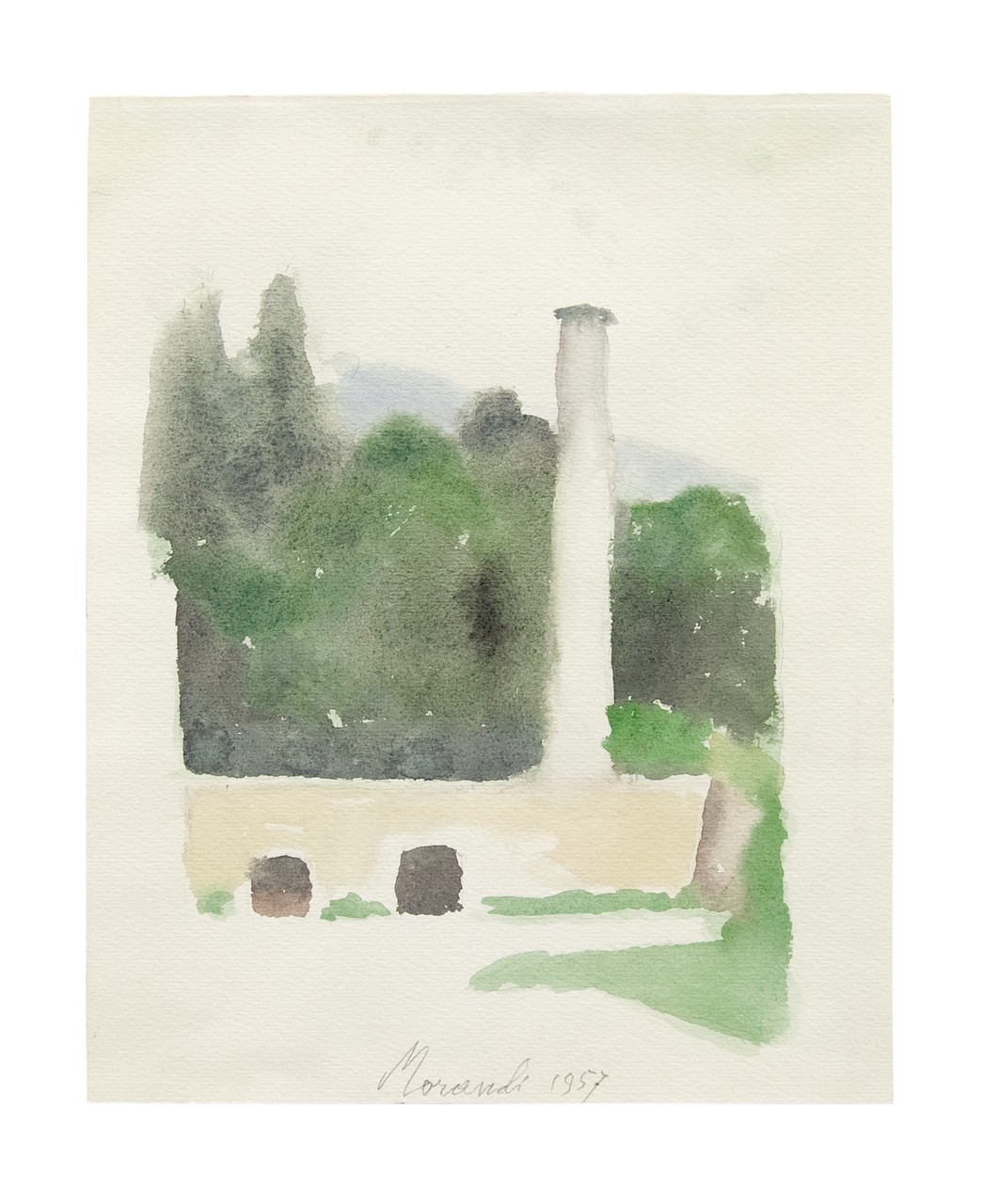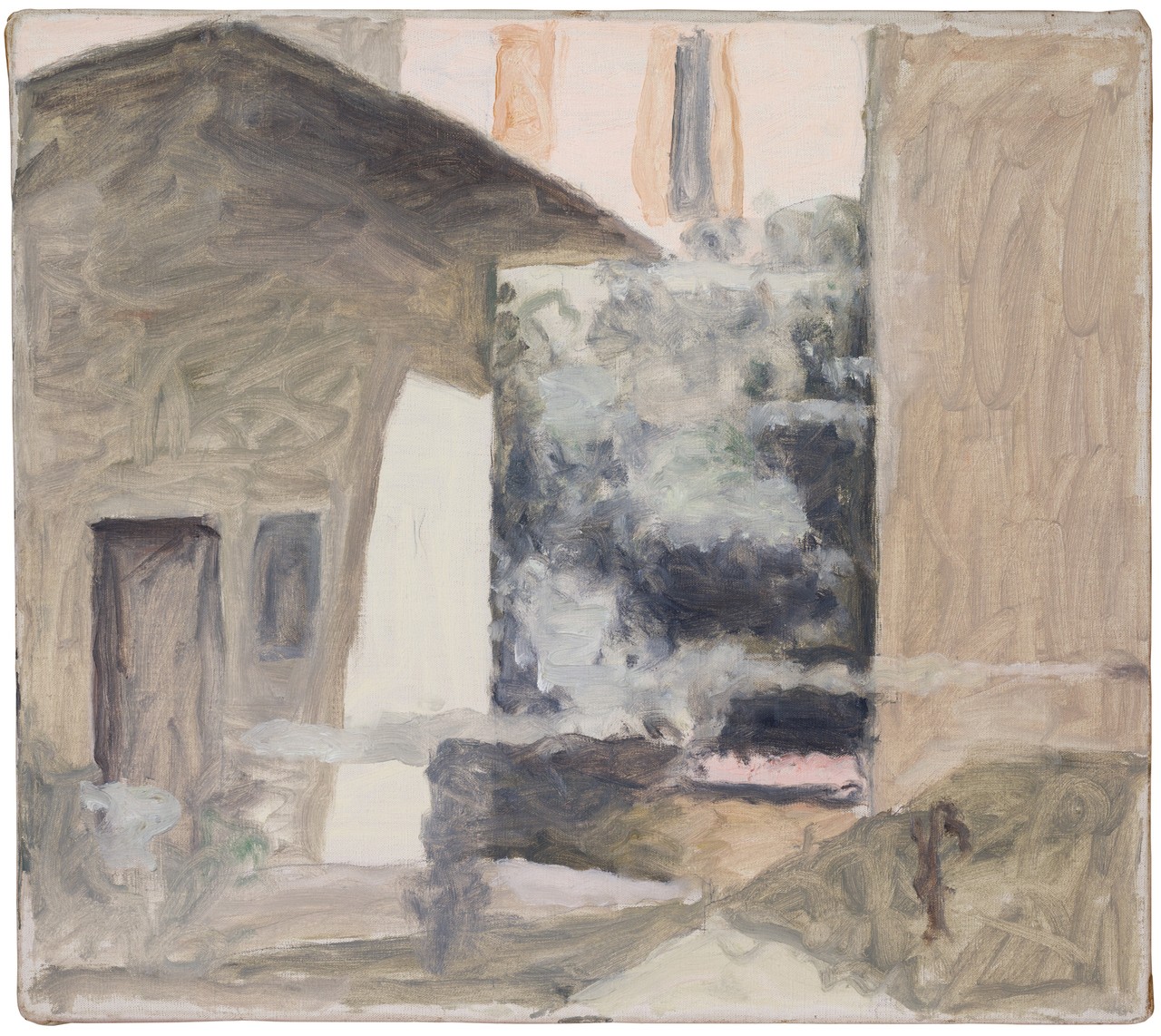Giorgio Morandi
04 Nov - 09 Dec 2017

Giorgio Morandi, Natura morta, Oil on canvas, 27,5 x 40,8 cm / 10 7/8 x 16 in
Morat-Institut für Kunst und Kunstwissenschaft, Freiburg im Breisgau
Photo: Hartmut Schmidt
© VG Bild-Kunst, Bonn 2017
Morat-Institut für Kunst und Kunstwissenschaft, Freiburg im Breisgau
Photo: Hartmut Schmidt
© VG Bild-Kunst, Bonn 2017

Giorgio Morandi, Natura morta, 1957, Oil on canvas, 38 x 36 cm / 15 x 14 1/8 in
Private Collection, Photo: Jochen Littkemann
© VG Bild-Kunst, Bonn 2017
Private Collection, Photo: Jochen Littkemann
© VG Bild-Kunst, Bonn 2017

Giorgio Morandi, Paesaggio, 1957, Watercolor and pencil on paper
26,4 x 20,3 cm / 10 3/8 x 8 in
Private Collection
© VG Bild-Kunst, Bonn 2017
26,4 x 20,3 cm / 10 3/8 x 8 in
Private Collection
© VG Bild-Kunst, Bonn 2017

Giorgio Morandi, Cortile di via Fondazza, 1959, Oil on canvas
40,5 x 45,5 cm / 16 x 17 7/8 in
Private Collection, Photo: Christopher Clem Franken, Cologne
© VG Bild-Kunst, Bonn 2017
40,5 x 45,5 cm / 16 x 17 7/8 in
Private Collection, Photo: Christopher Clem Franken, Cologne
© VG Bild-Kunst, Bonn 2017
Twenty years after the epoch-making presentation GIORGIO MORANDI in the premises on Wallrafplatz (1996/97), in the aftermath of which numerous international museums purchased works by Morandi for their collections, Galerie Karsten Greve is now displaying not only important paintings but also watercolours, drawings and other graphic works of the world-famous Italian master, mostly from well-known private collections, in a comprehensive exhibition of outstanding quality. In view of the size of one of the last institutional retrospectives, held in the Kunstmuseum Winterthur in 2000, the current exhibition of more than fifty first-class works, including 38 still-lifes and 15 landscapes, can truly be said to be of museum quality, providing a singular opportunity for a profound insight into the many-layered œuvre of this artist.
For Giorgio Morandi (1890–1964), who rarely left his home city of Bologna, and apart from a few trips to Switzerland never travelled abroad, his immediate surroundings were always at the focus of attention. The searching eye of Morandi the observer recognized the inexhaustible variety inherent in unspectacular everyday objects, a variety which can be experienced through close examination. ‘One can travel the world without seeing anything. To understand something, there is no need to see many things. One just has to inspect them closely.’ (Morandi)
The starting point for Morandi’s complete œuvre is the everyday utilitarian object, household items such as dishes, jars, bottles, jugs, mugs and vases, which, by the use of elaborate arrangements, he places in ever new mutual associations. Starting from these real situations – which also include the view from the window – Morandi creates a basic repertoire of motifs which he uses in order to pursue, all the way to the borders of abstraction, his confrontation with painterly elements such as form, colour and volume.
In numerous different combinations, which he creates in a meticulous selection procedure and places against a monochrome, neutral background, he tirelessly plumbs the mutual relationships between things, painstakingly studying the effect of light and shade, as well as the interplay of contours, spatial co-ordinates and areas of colour in a variable compositional structure. The objects which Morandi carefully places, as if on a stage, are often re-arranged and exchanged. Intervals are re-assessed, proportions changed, light-and-dark effects created. In this mise-en-scène, minor shifts in the arrangement give rise to crucial transformations of the whole picture. The multifariousness of the resulting variations meant for Morandi that the ‘encounter of a coffee-pot with a vase on a table remained an unsolved and highly relevant problem right up to his death in 1964’ (C. Spies). In addition, Morandi explores the relationship between occupied space and the unoccupied space in between, allowing contours to stand out in contrast, so that even the empty spaces in the picture are given, so to speak, an outline and thus a concrete presence. As with the sort of puzzle picture where background becomes foreground and vice versa, the result is sometimes a confusing, not to say irritating, equivalence of positive, filled-in areas on the one hand, and negative, deliberately empty, areas on the other. The existential distinction between presence and absence is abolished. Released from their real-life context, the depicted objects often lose their spatial and temporal orientation, while their silent, statuesque presence comes across as archaic and timeless.
As a result, Morandi succeeded in bestowing a certain monumentality of the miniature status of his humble motifs, so that the jugs and vases, as stand-alone entities in space, take on the gravity of buildings. Although Morandi vigorously rejected any relationship with Pittura Metafisica, with which he grappled in 1918 and 1919, and saw his artistic endeavours more in the context of the Italian masters of the Trecento and Quattrocento, his compositional structures, in their painstaking balance between filled and unfilled pictorial zones, contain echoes of the staffage of Giorgio de Chirico’s stage-like, usually deserted public spaces.
Morandi does not strive for a faithful reproduction of a reality bound to real space, but is concerned, rather, with the artistic shaping of the pictorial space, with the exploration of painterly possibilities. ‘The only interest the visible world arouses in me,’ he once wrote, ‘concerns space, light, colour and forms.’ These fleeting phenomena create a changeable reality, which is hard to pin down. Morandi shared this concept of reality, which is not unchanging and constant, but can be experienced in the alternation of moods and impressions, with Paul Cézanne, who placed the individual gaze, the subjective artistic perception, and the artificiality of the aesthetic experience above the mere reproduction of reality. While the Cubists dissected forms into their individual facets and the Futurists sought the dynamic dissolution of form in dense sequences of movement units, Morandi devoted himself to form in its changing manifestation. He created concentrated impressions reduced to their essentials, ‘impressions’ of this inconstant reality, whose elements ultimately, in his late work, almost dissolve into abstraction.
The present catalogue to the exhibition includes, alongside high-quality illustrations of the exhibits, two informative articles by Prof. Christian Spies, curator of the Lambrecht-Schadeberg Collection at the Museum für Gegenwartskunst, Siegen, and Neville Rowley, curator of Early Italian Art at the Staatliche Museen zu Berlin. In his scholarly contribution ‘Der Anachronist als Zeitgenosse’ (‘The Anachronist as Contemporary’), Prof. Spies closely relates Morandi’s œuvre to that of the masters of the Trecento and Quattrocento, while Neville Rowley uses a particular circumstance to reveal Morandi’s understanding of himself as an artist.
For Giorgio Morandi (1890–1964), who rarely left his home city of Bologna, and apart from a few trips to Switzerland never travelled abroad, his immediate surroundings were always at the focus of attention. The searching eye of Morandi the observer recognized the inexhaustible variety inherent in unspectacular everyday objects, a variety which can be experienced through close examination. ‘One can travel the world without seeing anything. To understand something, there is no need to see many things. One just has to inspect them closely.’ (Morandi)
The starting point for Morandi’s complete œuvre is the everyday utilitarian object, household items such as dishes, jars, bottles, jugs, mugs and vases, which, by the use of elaborate arrangements, he places in ever new mutual associations. Starting from these real situations – which also include the view from the window – Morandi creates a basic repertoire of motifs which he uses in order to pursue, all the way to the borders of abstraction, his confrontation with painterly elements such as form, colour and volume.
In numerous different combinations, which he creates in a meticulous selection procedure and places against a monochrome, neutral background, he tirelessly plumbs the mutual relationships between things, painstakingly studying the effect of light and shade, as well as the interplay of contours, spatial co-ordinates and areas of colour in a variable compositional structure. The objects which Morandi carefully places, as if on a stage, are often re-arranged and exchanged. Intervals are re-assessed, proportions changed, light-and-dark effects created. In this mise-en-scène, minor shifts in the arrangement give rise to crucial transformations of the whole picture. The multifariousness of the resulting variations meant for Morandi that the ‘encounter of a coffee-pot with a vase on a table remained an unsolved and highly relevant problem right up to his death in 1964’ (C. Spies). In addition, Morandi explores the relationship between occupied space and the unoccupied space in between, allowing contours to stand out in contrast, so that even the empty spaces in the picture are given, so to speak, an outline and thus a concrete presence. As with the sort of puzzle picture where background becomes foreground and vice versa, the result is sometimes a confusing, not to say irritating, equivalence of positive, filled-in areas on the one hand, and negative, deliberately empty, areas on the other. The existential distinction between presence and absence is abolished. Released from their real-life context, the depicted objects often lose their spatial and temporal orientation, while their silent, statuesque presence comes across as archaic and timeless.
As a result, Morandi succeeded in bestowing a certain monumentality of the miniature status of his humble motifs, so that the jugs and vases, as stand-alone entities in space, take on the gravity of buildings. Although Morandi vigorously rejected any relationship with Pittura Metafisica, with which he grappled in 1918 and 1919, and saw his artistic endeavours more in the context of the Italian masters of the Trecento and Quattrocento, his compositional structures, in their painstaking balance between filled and unfilled pictorial zones, contain echoes of the staffage of Giorgio de Chirico’s stage-like, usually deserted public spaces.
Morandi does not strive for a faithful reproduction of a reality bound to real space, but is concerned, rather, with the artistic shaping of the pictorial space, with the exploration of painterly possibilities. ‘The only interest the visible world arouses in me,’ he once wrote, ‘concerns space, light, colour and forms.’ These fleeting phenomena create a changeable reality, which is hard to pin down. Morandi shared this concept of reality, which is not unchanging and constant, but can be experienced in the alternation of moods and impressions, with Paul Cézanne, who placed the individual gaze, the subjective artistic perception, and the artificiality of the aesthetic experience above the mere reproduction of reality. While the Cubists dissected forms into their individual facets and the Futurists sought the dynamic dissolution of form in dense sequences of movement units, Morandi devoted himself to form in its changing manifestation. He created concentrated impressions reduced to their essentials, ‘impressions’ of this inconstant reality, whose elements ultimately, in his late work, almost dissolve into abstraction.
The present catalogue to the exhibition includes, alongside high-quality illustrations of the exhibits, two informative articles by Prof. Christian Spies, curator of the Lambrecht-Schadeberg Collection at the Museum für Gegenwartskunst, Siegen, and Neville Rowley, curator of Early Italian Art at the Staatliche Museen zu Berlin. In his scholarly contribution ‘Der Anachronist als Zeitgenosse’ (‘The Anachronist as Contemporary’), Prof. Spies closely relates Morandi’s œuvre to that of the masters of the Trecento and Quattrocento, while Neville Rowley uses a particular circumstance to reveal Morandi’s understanding of himself as an artist.
